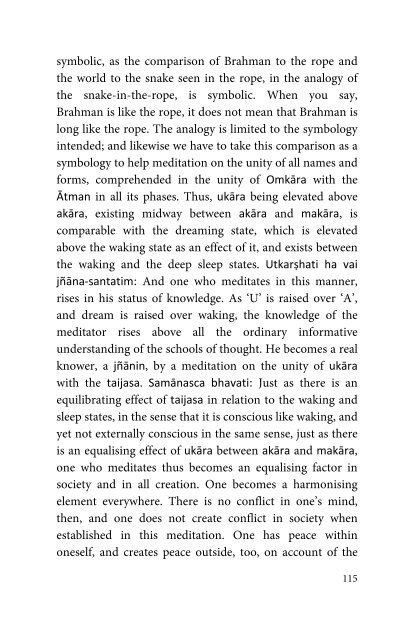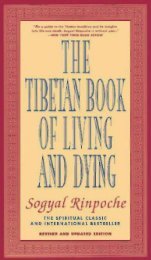which brings about a result of this nature, when one resortsto meditation in this manner.Now, the <strong>Upanishad</strong> proceeds further to a comparisonof the second syllable of Omkāra, namely ‘U’, with thesecond phase of the manifested Ātman, namely, taijasa.Ukāra is the second syllable of Om, which can becompared with the second pāda or foot of the Ātman. Theukāra is regarded as utkarṣha or elevated in the sense that itis beyond akāra, proceeds after akāra. In the series of theletters of the alphabet, ‘U’ comes after, as an effect, as itwere, of the pronunciation of akāra; and while akāra maybe regarded as the commencement of language, ukāra is themiddle of all vowel-formations. When you utter ‘U’, youfind that the middle of the throat begins to function. It iselevated, symbolically, says the <strong>Upanishad</strong>, in the sense thatit is above akāra in the process of word-formation. So alsois taijasa or dream-consciousness that comes afterwards asan effect of the waking experience; proceeding from thewaking experience, existing midway between waking andsleep. Ubhayatvādvā; It is ubhaya, or both, in the sense thatit has two sides, namely, waking and sleep, from the pointof view of the pādas of the Ātman, and it is between akāraand makāra, from the point of view of the mātrās, orsyllables, of Omkāra. Thus we can compare, in meditation,ukāra with taijasa, the dreaming consciousness. Thesecomparisons are made by the <strong>Upanishad</strong> to help one inmeditation, so that one can bring Omkāra in juxtapositionwith the states of the Ātman. All these comparisons aresymbolic, and we should not take them literally. Allmeditations are symbolic; all vidyās of the <strong>Upanishad</strong>s are114
symbolic, as the comparison of Brahman to the rope andthe world to the snake seen in the rope, in the analogy ofthe snake-in-the-rope, is symbolic. When you say,Brahman is like the rope, it does not mean that Brahman islong like the rope. The analogy is limited to the symbologyintended; and likewise we have to take this comparison as asymbology to help meditation on the unity of all names andforms, comprehended in the unity of Omkāra with theĀtman in all its phases. Thus, ukāra being elevated aboveakāra, existing midway between akāra and makāra, iscomparable with the dreaming state, which is elevatedabove the waking state as an effect of it, and exists betweenthe waking and the deep sleep states. Utkarṣhati ha vaijñāna-santatim: And one who meditates in this manner,rises in his status of knowledge. As ‘U’ is raised over ‘A’,and dream is raised over waking, the knowledge of themeditator rises above all the ordinary informativeunderstanding of the schools of thought. He becomes a realknower, a jñānin, by a meditation on the unity of ukārawith the taijasa. Samānasca bhavati: Just as there is anequilibrating effect of taijasa in relation to the waking andsleep states, in the sense that it is conscious like waking, andyet not externally conscious in the same sense, just as thereis an equalising effect of ukāra between akāra and makāra,one who meditates thus becomes an equalising factor insociety and in all creation. One becomes a harmonisingelement everywhere. There is no conflict in one’s mind,then, and one does not create conflict in society whenestablished in this meditation. One has peace withinoneself, and creates peace outside, too, on account of the115
- Page 1 and 2:
THE MĀNDŪKYAUPANISHADSWAMI KRISHN
- Page 3 and 4:
CONTENTSPublishers’ Preface ...
- Page 5 and 6:
INTRODUCTIONThe theme of the Manduk
- Page 7 and 8:
ceases to agitate the mind any more
- Page 9 and 10:
INVOCATION AND VERSESOm! Bhadram ka
- Page 11 and 12:
svapna-sthāno’ntaḥ-prajñaḥ
- Page 13 and 14:
8. This identical Ātman, or Self,
- Page 15 and 16:
THE PRANAVA OR OMKARAThe Vedas, in
- Page 17 and 18:
and rūpa, name as well as form. It
- Page 19 and 20:
Now, we come from what we call Īsv
- Page 21 and 22:
and to achieve this by a direct met
- Page 23 and 24:
structure and the glory of Om. With
- Page 25 and 26:
desire persisting, it would only po
- Page 27 and 28:
magnificence of Om, but how are we
- Page 29 and 30:
experience a thrill, as if an elect
- Page 31 and 32:
THE INDIVIDUAL AND THE ABSOLUTEThe
- Page 33 and 34:
vai tat. The reconciliation of “t
- Page 35 and 36:
yaccānyat trikālātitam tadapyomk
- Page 37 and 38:
The ultimate longing of all aspirin
- Page 39 and 40:
to the realisation of asti-bhāti-p
- Page 41 and 42:
structural difference is an effect
- Page 43 and 44:
self is the false self, not the rea
- Page 45 and 46:
cow, with four feet? The four feet
- Page 47 and 48:
Consciousness. A study of conscious
- Page 49 and 50:
THE UNIVERSAL VAIŚVĀNARAThis Ātm
- Page 51 and 52:
these dealings are with ‘other’
- Page 53 and 54:
the Virāt, or the Universal Person
- Page 55 and 56:
logical discrimination. This is the
- Page 57 and 58:
it were. This is the function of th
- Page 59 and 60:
world’s existence, not merely a p
- Page 61 and 62:
subtle body is not visible to us, a
- Page 63 and 64: Now, we consider the meaning of bah
- Page 65 and 66: ecause the consciousness of the jī
- Page 67 and 68: cannot have power over things. We a
- Page 69 and 70: we have about the dream world in re
- Page 71 and 72: is a complicated case for investiga
- Page 73 and 74: never pass such a judgment. You are
- Page 75 and 76: are in a particular state, that sta
- Page 77 and 78: But, if you feel that by waking up
- Page 79 and 80: The dream consciousness which is ta
- Page 81 and 82: ecause freewill is only as much rea
- Page 83 and 84: Dreams, therefore, are due to repre
- Page 85 and 86: egarded as pravivikta, sūkṣhma,
- Page 87 and 88: The third foot of the Ātman the th
- Page 89 and 90: ānanda, swallow ānanda, consume
- Page 91 and 92: Causal Condition, known as Īsvara.
- Page 93 and 94: ocean is being described here, the
- Page 95 and 96: of an effect, namely, the plant, an
- Page 97 and 98: Īsvara’s Being. For Him, it is a
- Page 99 and 100: or Destroyer, more than a cause of
- Page 101 and 102: which you have seen, heard, etc.? B
- Page 103 and 104: where existence becomes identical w
- Page 105 and 106: simply are. You have become That, a
- Page 107 and 108: peaceful. But the peace of the Ātm
- Page 109 and 110: seen the Ātman? Can you get the Ā
- Page 111 and 112: THE ĀTMAN AS THE PRANAVAThe Ātman
- Page 113: the Ātman in the waking state is c
- Page 117 and 118: Therefore, your generation, your po
- Page 119 and 120: the deep sleep state, even as all o
- Page 121 and 122: elationless. Samviśatyatmanātmān



